Kristine Hughes's Blog, page 81
January 18, 2015
LOOSE IN LONDON: KRISTINE MUSES ON MUDLARKING
You may recall a prior post about mudlarking on the River Thames that I wrote a few years ago - you'll find it here. I had been longing to return to the River again and was chuffed when Victoria said she'd like to take a turn at mudlarking while we were in London.
Victoria and I started out as part of a London Walks mudlarking tour on Sunday morning, with at least thirty other people in our group. The group was so big that the guide and her assistant broke us up into two groups, while she went back and forth relating the history of the Thames, it’s bridges and, incidentally, mud larking. This went on for quite some time before Victoriasidled up and asked me if we were ever going to get the opportunity to actually get our hands dirty, so to speak. After all, we were almost an hour into the walk and we were still on the northern side of the river.
Finally, we got across the Thamesand no sooner had we arrived then we lost the tour group. Both tour groups, in fact. The guide had organized us, in two groups, around a set of steps while she told us about something to do with shipping history. Victoria and I had only briefly wandered away and when we turned back, all thirty-something of them had vanished. Considering the size of the two groups, it was uncanny that we could find no sign of any of them. Poof! and they were gone. This did not bode well for our own turns as tour guides in the not too distant future.

“What are we going to do now?” Victoria asked, a tad worried.
“We go mud larking, as planned.”
“But where?”
“Anywhere. There are several sets of stairs on this side of the Thames that lead down the river. If the gate at the top of the steps is unlocked, all we have to do is climb down to the river bank.” I looked over the railings on the Queen’s Walk to the riverbed below. “Look,” I said, pointing at some near distant mud larkers. “They’ve gotten themselves down there, we can, too.”
“Are we allowed? I mean, can we just go down at any point, or is there a designated mud larking spot?”
“Well, no one’s ever stopped me before. If a Peeler with a truncheon comes along and threatens to haul us in as vagrants, we’ll move on. Come on, we’ll go down to the steps that Brooke and I used last time. I know they’re accessible.”
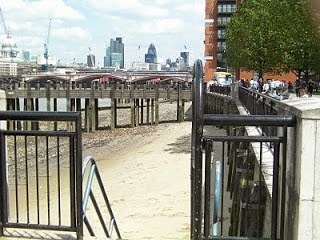
So we walked down to the spot in question and sure enough, the gates were unlocked. Not only that, but there was some sort of Clean Up the River type event going on, so there were several people picking through the sand already. Vicky and I got out our Ziploc bags and climbed down the stairs.
“You want to pick through the stuff at the top here, near the wall and stairs. Everyone typically heads for the waterline first, and they walk right past some good stuff. Here,” I went on, ”take this stick and use it to push the sand aside.” Within minutes, Vicky was mud larking like a pro, searching for blue and white pottery shards and anything else of interest. I found myself a large, flat shell and used that to dig with.

Here's a photo of me on the River bank, wearing my now famous fur lined boots. Before long, Victoria and I had drifted apart. Her wanderings took her in one direction, mine in another as we both dug through a few decades, if not centuries, of silt and sand.
I love standing on the river bank with the tide out, exposing bits of Londononly a few people get to see. It’s a way of communing with London, of getting to the heart of the City I love best. It isn't glamorous, rather it's real life at its most rough and ready. At one time, it was home to those who were London’s poorest – the mud larks who combed this stretch of river bank in search of anything of any value that they could turn into coin for a meal or a bed for the night. Just think of all of their stories, the tales that could be told by people who sailed the river, worked the river, whose lives were tied in some way or another to the eternal rhythm, the ebb and flow of the mighty Thames.
I'll always remember seeing the opening scenes in one of the Robert Downey Jr. Sherlock Holmes films - the London docks of the 19th century. Never had I seen movie set that looked so exactly as I had always pictured a place in my mind's eye. I felt that what I was looking at was 19th century London, magically brought to life on the screen. Imagine my dismay when I later found out that the scenes had actually been shot at Stanley Docks in Liverpool. Here's a trailer from the film - there's actually very little of the docks in the clip, but it's a hoot.
You'll see from the photos below that it was glorious London day, perfect weather for being outdoors. This is what the riverbank looked like when we were there.

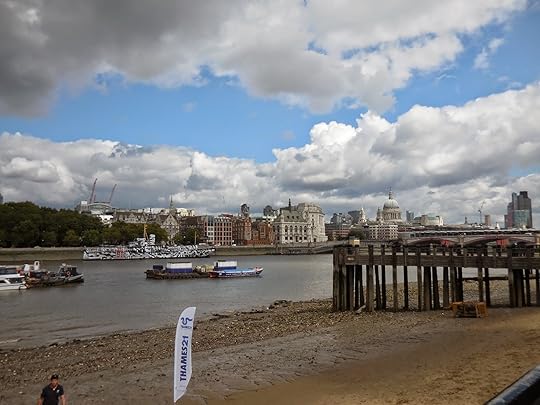
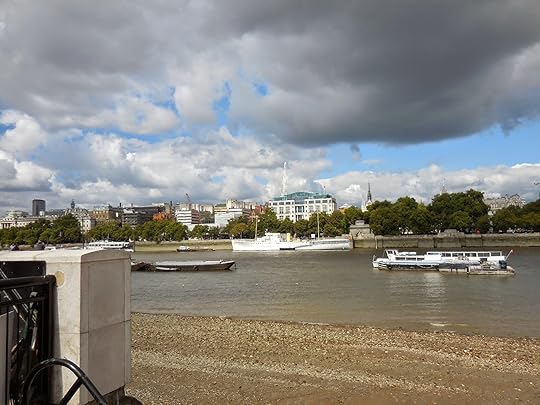
However, this is what I saw in my mind's eye as I gazed out at the Thames.

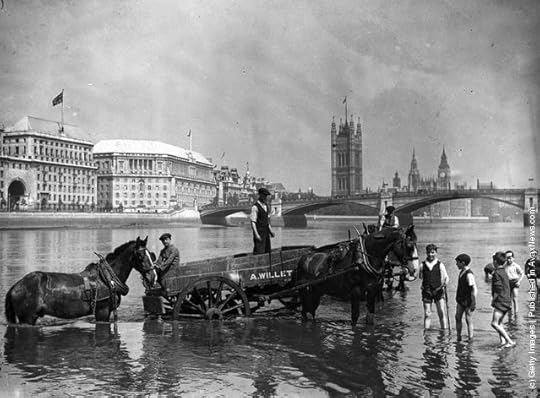

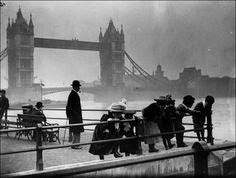
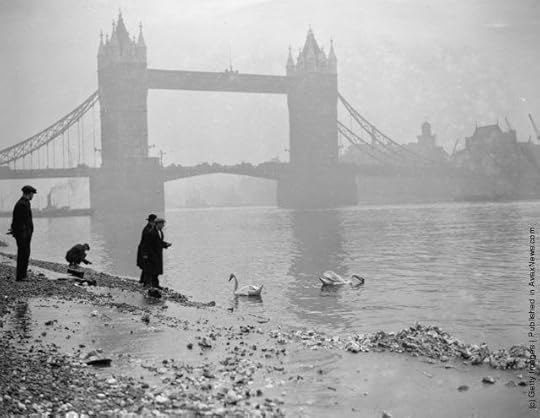
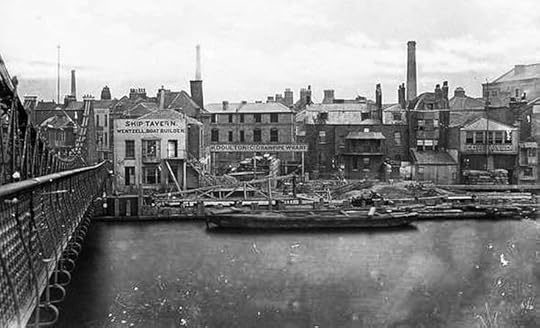
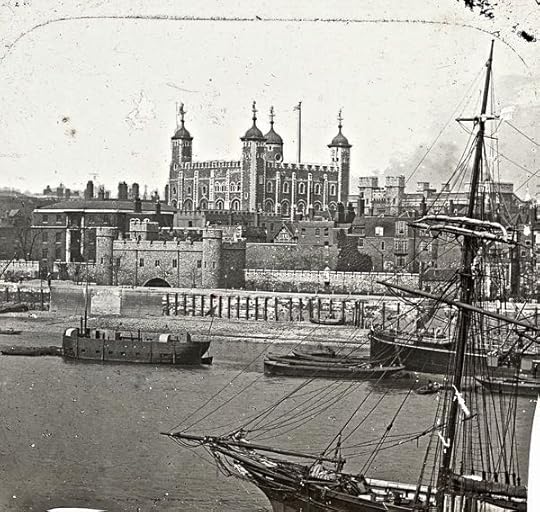

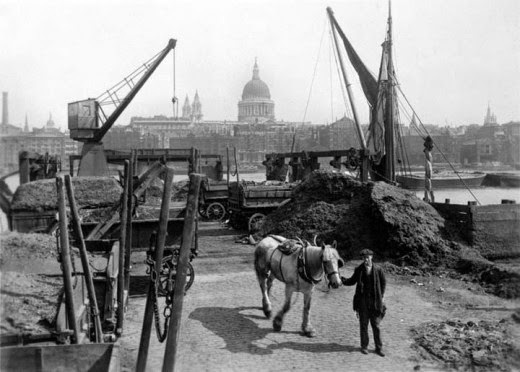

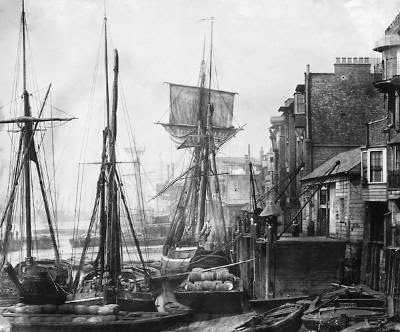
Yes, Victoria, I was picturing a place where everyone was wearing period costume. And sailing in period ships.
Back in the 21st century, Victoria and I had a fabulous time collecting treasures from the River. Pottery shards, pipe stems and bowls, animal bones, driftwood, bits of metal and, most surprisingly, shells. We spent not a few hours treasure hunting before I looked up to see Victoriafurther ahead, waving an arm at me in a universal gesture that meant "get over here."
"We've got to wrap things up," she said when I'd reached her. "We need to eat something and then make our way over to Clarence House." We'd booked a tour of Clarence House for four o'clock that afternoon, another place we'd always wanted to see, but which is rarely open to the public.
Reluctantly, I agreed but stopped by the station the Clean Up the Thames group had set up nearby. In addition to the sand sculptures below, they had set up a table manned by River historians and archaeologists who were available to a provide insight into the items people had found that day.
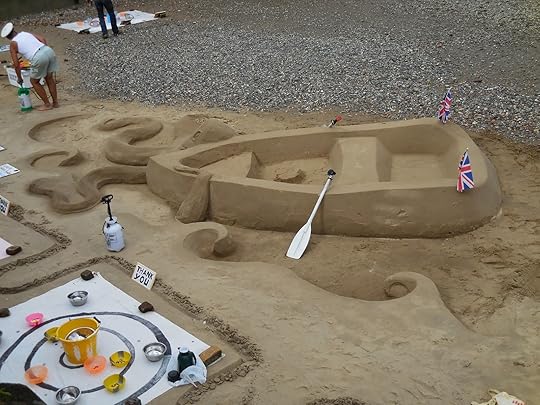
I showed them the bones I had found and their best guess was that they had probably come from a dog.
My pottery shards were fairly self explanatory.
The pipe stems and pipe bowl I'd found were a different story. They actually had a book with them containing pipes of all periods and going by the shape and size of my pipe, they were able to tell me that mine was early 18th century. The photo above doesn't do justice to the pipe bowl, it has a very elaborate design carved into the bowl. The expert was much taken with it and told me that it had to have belonged to someone of means. These pipes were meant to be disposable. One bought one already filled with tobacco, smoked it and chucked it away, many times into the River.. They weren't typically the sort of item one spent time carving designs into. He was quite impressed and I was dead chuffed.
Perhaps my most interesting find was this tooth. I'm holding it upside down so that you can see the three rather large roots. The consensus is that it had probably come from a horse.
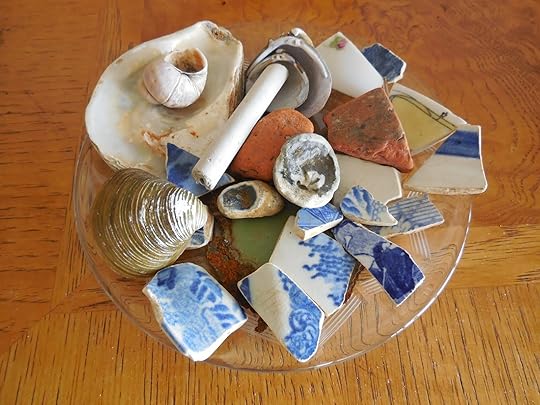
Victoria's treasures were much prettier and are pictured above: shells, clay pipe stem, blue-and-white shards, tile pieces.
You'll find the black and white River photos above and many more period photos of all areas of London and London life on my Pinterest board, Old London.
More Loose in London Coming Soon!
Published on January 18, 2015 23:30
January 15, 2015
UPCOMING EVENTS AT THE LEIGHTON HOUSE MUSEUM

The fabulous Leighton House Museum has so many fabulous special events coming up that we wanted to share them with you so that you can pencil them into your social calendars. If you've never been to the Musuem, any one of these events would be the prefect reason for doing so.
EXHIBITION EVENTS PROGRAMMEBookings: www.eventbrite.co.uk
LATE NIGHTS AT THE MUSEUM22 January | 19 February | 26 March 2015The Museum will remain open until 8.30pm.Entry by timed ticket only; last entry is at 7.45pm.
CURATOR TOURS11 February | 5 March 20156:30 to 7:30pm; doors open at 6pmTickets: £25Special evening tours of the House and exhibition by Victorian art specialists including a glass of wine. Numbers are limited so early booking is advised.
BALLOON DEBATE: VICTORIAN MASTERS REVISITED4 March7pm to 9pm; doors open at 6:30pmTickets: £20Join Alison Smith, (Tate Britain), Stephen Wildman (University of Lancaster), Julian Treuherz (Art Historian) and Christopher Newall, independent scholar and curator, as they discuss the relative merits of the Victorian Masters featured in A Victorian Obsession. An entertaining and enlightening evening chaired by art historian Colin Cruise that will shed light on the collection and its artists; not only as individuals but also as part of a bigger picture. The debate will conclude with questions from the floor and a show of hands - which artist will win the public's vote? 3
LIFE-DRAWING CLASSES20 January | 17 February | 17 March 20151pm – 4pmTickets: £35 per sessionSPECIAL OFFER: book three separate classes and save £15Artists of all levels are invited to Leighton House for a series of afternoons of guided instruction in the craft of drawing from life. Each session will consist of a mixture of short exercises and longer poses, with reference to objects of the permanent collection and work on show. Course led by Lavender Hill. Studios founder and director, Ann Witheridge.
ARTISTS IN RESIDENCE14 January | 18 February | 11 March 2015To mark the opening of A Victorian Obsession exhibition and in celebration of Lavender Hill Studios’ 10th anniversary, Leighton House is hosting an Artist-in-Residence programme welcoming two artists over a ten week period each. The chosen artists will spend a day a week, drawing and painting at Leighton’s studio on the first floor, producing work in response to the temporary collection and to the environment.
PRACTICAL WORKSHOP3 March 201510am – 3pmTickets: £35A rare opportunity to learn about the traditional materials used by an artist, from an artist and materials expert, Scott Pohlschmidt.
A VICTORIAN OBSESSION : AN EVENING OF MUSIC12 February 20157:15pm – 10pmTickets: £25Tenor Richard Edgar-Wilson with violinist Kathryn Parry and pianist Juliet Edwards will weave a tapestry of musical delights under the stewardship of compere Sandy Burnett that will include an aria from Cavalli’s unpublished opera Eliogabalo and music by Mendelssohn, Elgar, Brahms and Debussy inspired by the same poets and poetry that so affected the Victorian artists. The concert will feature the magical Lark Ascending in Vaughan Williams’ original version for violin and piano.
DESPERATE ROMANTICS: AN AESTHETIC SOIRÉE25 February 20157pm – 8.30pm, doors open at 6:30pmTickets: £25 4Hosted by academic and broadcaster Peggy Reynolds (BBC Radio 3 Adventures in Poetry), in discussion with art historian Jan Marsh, the event will also feature special live performances of some classic poetry from the likes of Dante Gabriel Rossetti, Browning and Swinburne.
THE MUSE – A NEW PLAY by Katherine Tozer13, 14, 19, 20, 23, 24, 25, 27 and 28 March 20157:45pm – 9pmTickets: £25Following the sell-out success of the production Hedda, at Leighton House in April 2014 Palimpsest theatre, film and web company return to present an extended run of a new multi-media play that explores the relationship between Lord Leighton and Dorothy Dene, his model, muse and confidante.
Leighton House Museum12 Holland Park RoadLondon W14 8LZMonday to Friday: +44 (0) 20 7602 3316
Saturday and Sunday: +44 (0) 20 7471 9160
Published on January 15, 2015 23:30
January 14, 2015
AND FROM ELSEWHERE AROUND THE WEB . . . . . . . .

Spitalfields Life - A New Home for Old Family Photographs
Risky Regencies - From Ice to Ice Cream
The Chirugeon's Apprentice - 19th Century Safety Coffins
English Buildings - Savile Row, London
Laurie Benson's Cozy Drawing Room - Mourning Pictures: An Expression of Grief in Georgian England
Reading the Pastt - A review of The Downstairs Maid by Rosie Clarke
English Historical Fiction Authors - The Importance of Horse Gaits in the Past
Published on January 14, 2015 00:00
January 12, 2015
LOOSE IN LONDON: WHAT KRISTINE SAW AT HIGHGATE CEMETERY
Victoria and I had finally arrived at Highgate Cemetery. It was a glorious afternoon - warm, sun shiny and the Cemetery was practically deserted. We were able to stroll the lanes and explore the East Cemetery all on our lonesomes. Save for the occasional birdsong, the air was still, quiet and the graves themselves were quite beautiful.
Victoria and I strolled in companionable silence, she a bit ahead of me as I threaded my way past crosses and angels, stopping to read some of the gravestones. At one time, all of these people were the light of someone's life - a cherished spouse, a beloved child, a much missed grandparent, a favourite sibling or one's closest friend. They were mourned, tears were shed over their loss and their graves were no doubt tended faithfully. Now, one hundred years on at least, they were nothing but forgotten bones in a cemetery, albeit resting beneath impressive monuments. It is said that no one is truly gone as long as there is someone, one person, who continues to remember them. I doubted there were many resting here who still had someone to remember them in 2014.

Meandering down the path, I was brought up short by one of the next graves I encountered.

"Vicky!"
"Hmmm?"
"Look what I found."
"What is it?" she asked, coming to stand at my side. She read the gravestone and then looked at me. "Trust you to find a connection to Artie at Highgate. Who's Michael?"
"Who's Viscount Dangan?" I asked in return.
"Is it a family title?"
"Earl Cowley, Marquess of Douro, Lord Mornington . . . . . Viscount Wellesley I know. Dangan I do not."
"Maybe it's not even our Wellesleys."
"Has to be. How many other Wellesley families can there be? And how many who produced a viscount?" I looked at the stone again. "He was only six when he died."
Further research once I got home revealed that Michael would have been the Duke's grand nephew, a descendant of his brother Henry and one of Henry's children whom the Duke and Kitty helped to raise. He died of leukemia. ***

Eventually, Victoria and I made our way to the West Cemetery in order to join the 3 p.m. tour group. Once we were gathered, our tour guide gave us a brief history of the Cemetery, which opened in 1839. As we gathered in the large inner courtyard, our guide painted a vivid picture of the Cemetery as a thriving business concern - the courtyard would have been filled with hearses, carriages and male mourners as upwards of forty funerals a day were carried out on a typical day. Services had to be timed to the minute, as well as the arrival and departure of the attendant retinues, in order for everything to have run smoothly. You can read the Wikipedia entry on the Cemetery here.

The West Cemetery had a different feel to it from the East side - wilder, more imperfect, more tumble down, more macabre in a Hammer Studios way. In fact, it occurred to me that most of the cemeteries depicted on film had perhaps been modeled after the East Cemetery. Nothing could have been more perfect. Sunlight filtered through the branches overhead and our tour group followed the leader through the stillness as we took in the surrounding graves and monuments, the silence broken only by his commentary on what we were seeing and the history of funeral architecture.



Here, in the exclusive Egyptian Avenue, crypts were sold for the highest prices. Mourners coming to pay their respects often brought picnic lunches and erected tables within the crypts of their loved ones. Today, the plaques bearing the names of the departed are moss covered and the doors locked behind cobwebs that have been spun over the decades.


The Circle of Lebanon, above, is another of the exclusive section of crypts at the Cemetery. It was here that our guide took a detour and led us into an underground burial chamber. Once inside, there was almost no daylight, thus most of the photos I took did not come out well. Here's one of mine below.

And here's one taken in better light that I swiped off the internet so that you'd have a better idea of the space we were in. As I said, we were nearly in the pitch dark, surrounded on all sides by sealed crypts. As you can see in the photo below, there are sky lights in the ceiling, but by 2014 the vegetation had grown over them, dimming the space further. It was so dark that I had to step in close to peer at the stones that were marking the individual graves.
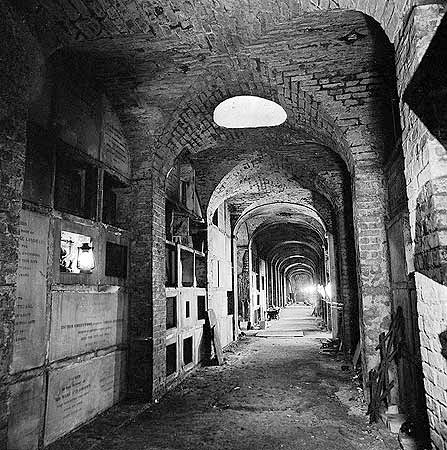
So you can imagine my surprise, nay shock, when I leaned down to read the lower stones only to be met by this sight.

Thank God the lid was still intact.

Perhaps one of my favourite graves is that of Tom Sayers, above. The grave stone, with the image of his faithful dog, a Mastiff named Lion, draped over his coffin as chief mourner is reminiscent of another of my favourite works of art, "The Old Shepherd's Chief Mourner," by Edwin Landseer.
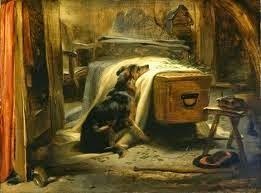
Our group stood around the grave appreciating the poignancy of it all until our guide asked if any of us knew who Tom Sayer was. No one spoke up and for a time I considered whether or not I should answer. It seemed that either Victoria or I had been the only ones to know the answer to several of our guides previous questions. Victoria had been the only one among us to know who the lesbian author Radclyffe Hall was, which delighted our guide. I was loathe to have the Americans once again provide the answer to his question. However, when it became apparent that no one else in the group was going to volunteer, I said, "A boxer. The best bare knuckle fighter in Victorian England."
The guide's eyes widened, "Yes! And it's not too far a stretch that an American should know the answer to that question, is it?"
"Not if you know the story," I answered. And so he began to relate the story of Sayers's career to our group. You can read all about it here.
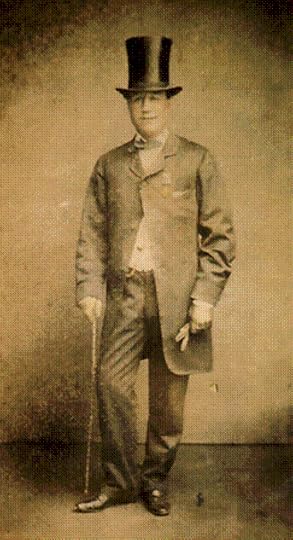
Sayers died in 1865 and huge crowds, made up of many of London's rabble rousers and fight enthusiasts, followed his funeral cortege to Highgate Cemetery on the day of his burial. As the Morning Post of 16 Nov. 1865 put it: The scene was “…an exhibition for which irredeemable blackguardism, brutal levity and barbaric ferocity, we are sure the like never disgraced the hallowed precincts of that most hallowed of spots – an English graveyard.”
On our way towards the exit near the end of our tour, Victoria called me over to see something she'd found in the underbrush.

A single, perfect wild strawberry to remind us that life goes on.
______________________________________________________
You'll find the Highgate Cemetery website here, which is full of information of interest, including lists of other notable graves and the history of the Cemetery. Do also check out the site of The Friends of Highgate Cemetery - these are the people who volunteer their time as guides and who are at the forefront of restoration and upkeep for the Cemetery.
*** From Wikipedia: Earl Cowley is a title in the Peerage of the United Kingdom. It was created in 1857 for the diplomat Henry Wellesley, 2nd Baron Cowley. He was Ambassador to France from 1852 to 1867. He was made Viscount Dangan, of Dangan in the County of Meath, at the same time as he was given the earldom. This title is also in the Peerage of the United Kingdom. Lord Cowley was the eldest son of Henry Wellesley, 1st Baron Cowley, who like his son served as Ambassador to France. In 1828 he was created Baron Cowley, of Wellesley in the County of Somerset, in the Peerage of the United Kingdom. A member of the prominent Wellesley family, Cowley was the fifth and youngest son of Garret Wellesley, 1st Earl of Mornington, and the younger brother of Arthur Wellesley, 1st Duke of Wellington, and Richard Wellesley, 1st Marquess Wellesley.
Published on January 12, 2015 00:00
January 9, 2015
MEET THE DUKE AND DUCHESS OF WELLINGTON

Arthur Charles Valerian Wellesley, 9th Duke of Wellington, OBE DL (born 19 August 1945), is the present Duke of Wellington. He is the son of Valerian Wellesley, 8th Duke of Wellington, and his wife, Diana McConnel.
He married Princess Antonia of Prussia (who no longer uses her royal title) on 3 February 1977 at St. Paul's Church, Knightsbridge,London. Princess Antonia of Prussia, Duchess of Wellington, Duchess of Ciudad Rodrigo, OBE (born 28 April 1955), is a great-granddaughter of Wilhelm II, German Emperor and is descended from Queen Victoria through her daughter, Princess Victoria. Antonia Elizabeth Brigid Louise Mansfeld was born in London on 28 April 1955, the daughter of Prince Frederick of Prussia and Lady Brigid Katherine Rachel Guinness, daughter of Rupert Guinness, 2nd Earl of Iveagh. She is the twin sister of Prince Rupert Alexander Frederick. She was educated at Cobham Hall School and King's College London (BA, English). She was awarded the OBE in the 2008 Birthday Honours for services to social housing as President of the Guiness Trust.
The Duke and Duchess of Wellington have five children:

Arthur Gerald Wellesley, Marquess of Douro (above, born 31 January 1978); married as of 4 June 2005 to the former model Jemma Kidd, a fashion stylist and great-granddaughter of Lord Beaverbrook. They have twins and a younger son:Lady Mae Madeleine (born 4 January 2010).Arthur Darcy, Earl of Mornington (born 4 January 2010).Lord Alfred (born 10 December 2014).[3]Lady Honor Victoria Wellesley (born 25 October 1979); married (as his second wife) the Honourable Orlando Montagu, younger son of the Earl of Sandwich, and had issue:Walter Montagu (born 3 December 2005); first grandchild of the Duke and the Duchess, then the Marquess and Marchioness of Douro.Nancy Jemima Montagu (born January 2007).Lady Mary Luise Wellesley (born 16 December 1986).[4]Lady Charlotte Anne Wellesley (born 8 October 1990); attends Oxford University.Lord Frederick Charles Wellesley (born 30 September 1992); attended Eton College.
Published on January 09, 2015 00:00
January 8, 2015
THE DUKE OF WELLINGTON LAID TO REST TODAY
Published on January 08, 2015 15:44
January 7, 2015
BATTLE OF NEW ORLEANS, JANUARY 8, 1815
For a listing of commemorative events in New Orleans this week, click here.
As we have noted from time to time on this blog, the War of 1812 between the United States and Great Britain took place in the years 1812-1814, with the Treaty of Ghent, supposedly ending the hostilities, signed on December 24, 1814. In those days of very slow communication, neither army on US territory knew of the settlement when the Battle of New Orleans was fought on January 8, 1815.
 General Jackson encourages his troops to repel the Highlanders1920 Painting by Edward Moran, with incorrect uniforms (no kilts were worn here)but trying to capture the spirit of the moment
General Jackson encourages his troops to repel the Highlanders1920 Painting by Edward Moran, with incorrect uniforms (no kilts were worn here)but trying to capture the spirit of the moment
The American commander was General Andrew Jackson, later the 7th President of the U.S.. The British were led by General Edward (Ned) Pakenham (1778-1815), younger brother of the Duchess of Wellington. Although the British Parliament had approved the treaty, and it had been signed by the Prince Regent on December 30, 1814, The U.S Senate did not ratify the treaty until February 18, 1815.
 Death of Pakenham, 1860by Felix O. C. Darley
Death of Pakenham, 1860by Felix O. C. Darley
Many British troops that fought in the Peninsula had been sent to fight in North America after the Peace of 1814. But since the War with Napoleon was over, there was no need to enforce trade restriction -- or board U.S. flag vessels on the high seas to look for so-called British Navy deserters.
 Andrew Jackson, 1819by Charles Willson Peale
Andrew Jackson, 1819by Charles Willson Peale
The battle was fought a few miles south of the New Orleans at Chalmette in a swampy area unfamiliar to the British troops, a fact which benefited the Americans. There had been some preliminary fights in previous weeks. The Americans had built some earthworks and as the British attacked, they were driven back. General Pakenham was killed along with many of his countrymen, totaling almost 300 dead and 1,300 wounded. The America casualties were 13 dead and over 50 missing or wounded. Like that of Admiral Nelson after Trafalgar, Pakenham's body was returned to England in a barrel of rum.
 The Battle of New Orleans, 1839, by Eugene Louis Lami, Louisiana State Museum
The Battle of New Orleans, 1839, by Eugene Louis Lami, Louisiana State Museum
The British withdrew to the Royal Navy vessels.which attacked Fort St. Philips the next day. For over a week, they attempted to breach the fort's defenses, but eventually withdrew on January 18, ending the final battle of the war.
Some of the British troops returned to Europe in time to participate in the Battle of Waterloo on June 18, 1815, but many did not get back across the Atlantic in time.
The Treaty of Ghent made few changes from the time before the war. The declared causes of the U.S. complaints were no longer in effect; other causes, such as the desire to take land from Canada, had not been achieved. The losers were, as it seemed throughout North American history, were the Native Americans. Various attempts to establish an Indian state came to naught.
About the only lasting memories of the War of 1812, from the U.S. side, were the burning of Washington and the writing of the National Anthem the Star Spangled Banner. For this aspect of the war, click here.
The British really don't remember the War of 1812 at all. But to our friends in Canada, it means a great deal. And in New Orleans this week, the battle will be re-enacted and other festivities are planned to commemorate 200th anniversary. For more information, click here.
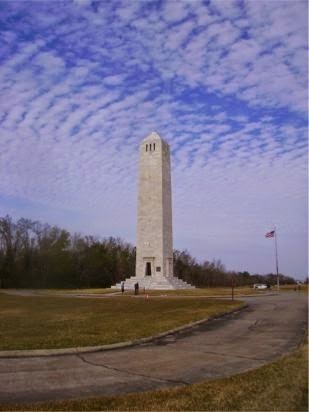 Chalmette Memorial Battle Site
Chalmette Memorial Battle Site
For more information on the National Park Service's Chalmette Battlefield, click here.
As we have noted from time to time on this blog, the War of 1812 between the United States and Great Britain took place in the years 1812-1814, with the Treaty of Ghent, supposedly ending the hostilities, signed on December 24, 1814. In those days of very slow communication, neither army on US territory knew of the settlement when the Battle of New Orleans was fought on January 8, 1815.
 General Jackson encourages his troops to repel the Highlanders1920 Painting by Edward Moran, with incorrect uniforms (no kilts were worn here)but trying to capture the spirit of the moment
General Jackson encourages his troops to repel the Highlanders1920 Painting by Edward Moran, with incorrect uniforms (no kilts were worn here)but trying to capture the spirit of the momentThe American commander was General Andrew Jackson, later the 7th President of the U.S.. The British were led by General Edward (Ned) Pakenham (1778-1815), younger brother of the Duchess of Wellington. Although the British Parliament had approved the treaty, and it had been signed by the Prince Regent on December 30, 1814, The U.S Senate did not ratify the treaty until February 18, 1815.
 Death of Pakenham, 1860by Felix O. C. Darley
Death of Pakenham, 1860by Felix O. C. DarleyMany British troops that fought in the Peninsula had been sent to fight in North America after the Peace of 1814. But since the War with Napoleon was over, there was no need to enforce trade restriction -- or board U.S. flag vessels on the high seas to look for so-called British Navy deserters.
 Andrew Jackson, 1819by Charles Willson Peale
Andrew Jackson, 1819by Charles Willson PealeThe battle was fought a few miles south of the New Orleans at Chalmette in a swampy area unfamiliar to the British troops, a fact which benefited the Americans. There had been some preliminary fights in previous weeks. The Americans had built some earthworks and as the British attacked, they were driven back. General Pakenham was killed along with many of his countrymen, totaling almost 300 dead and 1,300 wounded. The America casualties were 13 dead and over 50 missing or wounded. Like that of Admiral Nelson after Trafalgar, Pakenham's body was returned to England in a barrel of rum.
 The Battle of New Orleans, 1839, by Eugene Louis Lami, Louisiana State Museum
The Battle of New Orleans, 1839, by Eugene Louis Lami, Louisiana State MuseumThe British withdrew to the Royal Navy vessels.which attacked Fort St. Philips the next day. For over a week, they attempted to breach the fort's defenses, but eventually withdrew on January 18, ending the final battle of the war.
Some of the British troops returned to Europe in time to participate in the Battle of Waterloo on June 18, 1815, but many did not get back across the Atlantic in time.
The Treaty of Ghent made few changes from the time before the war. The declared causes of the U.S. complaints were no longer in effect; other causes, such as the desire to take land from Canada, had not been achieved. The losers were, as it seemed throughout North American history, were the Native Americans. Various attempts to establish an Indian state came to naught.
About the only lasting memories of the War of 1812, from the U.S. side, were the burning of Washington and the writing of the National Anthem the Star Spangled Banner. For this aspect of the war, click here.
The British really don't remember the War of 1812 at all. But to our friends in Canada, it means a great deal. And in New Orleans this week, the battle will be re-enacted and other festivities are planned to commemorate 200th anniversary. For more information, click here.
 Chalmette Memorial Battle Site
Chalmette Memorial Battle SiteFor more information on the National Park Service's Chalmette Battlefield, click here.
Published on January 07, 2015 00:30
January 5, 2015
LOOSE IN LONDON: HIGHGATE CEMETERY
After our morning at Kenwood, we still had a few particles of energy left...enough for a visit to Highgate Cemetery? Well, we'd only know if we gave it a try. So Kristine and Victoria climbed aboard a bus and trusted we'd remembered the right number -- and voila! Soon we were across the Heath and at the cemetery gates. From here on, this is Victoria's account. Kristine's will come in her own inimitable style.

Entrance Gates in Swain's Lane

We started out wandering in the East part of the cemetery, where individual rambles are allowed.

The paths are lined with memorials of all sizes and shapes.


I wonder if anyone has ever counted all the angels watching over the departed?


As we will see even more below, Mother Nature rules the area.

The draped urns on so many markers represent the soul and the image of grief.

Many kinds of crosses

We moved slowly, fascinated by the sights, and soon we had to hurry back to the West part of the cemetery for our guided tour, beginning at the Chapel. As you will see below, there is a reason to require guides for this larger part of the cemetery. It would be very easy to get lost!



Victorian Stained Glass in the Chapel




Monuments of all varieties
Highgate Cemetery is maintained and managed by a Friends group which organized to preserve the grounds. Though some of the monuments and graves are maintained by families, many were abandoned long ago. The Friends group keeps the natural growth under some control without trying to restore the appearance to that of the originals. It is also a wildlife refuge for all sorts of creatures, few of which ventured out while we humans were trudging around.
Areas on both sides of the cemetery are available for current burials, and among the Victorian monuments, you find recent graves here and there. One of the most famous is below.

Alexander Litvinenko (1962-2006) is widely believed to have been poisoned by Russian agents in London.

Author Beryl Bainbridge, DBE, 1932-2010,
And many old ones...

The tomb of General Sir Loftus Otway, 1775-1854, hero of the Peninsular Warand family members


The Egyptian Avenue,among the most exotic areas reflecting the Victorian imagination of the cemetery creators.

Circle of Lebanon

The Family Catacomb of P.W. Talbot of 439 Haverstock Hill

Vault of author Radclyffe Hall 1880-1943 and her partner Mabel BattenHall wrote The Well of Loneliness, 1928; admirers keep fresh flowers here always.

This horse is one of the numerous animals adorning gravesites.


Our Guide tells us about the tomb of George Wombwell 1777-1850known as The Menagerist, owner of a Victorian Traveling circus, interred below a statue of his favorite lion, Nero

Highgate was begun as a garden cemetery on the outskirts of London; by the mid-19th century, parish graveyards were running out of space. In 1836, Parliament established joint-stock companies to build cemeteries. Stephen Geary (1797-1854) headed the group that laid out (so to speak) Highgate, planning to hold 30,000 gravesites


The slope on which Highgate was located had excellent views and clear clean air, contributing to the appeal of the site.

Victorian families acquired lots in the cemetery and sometimes adorned them with statuary before anyone died. They often visited for picnics or just to admire their property.

In preparation for this visit, I read Audrey Niffenegger's interesting novel set at Highgate, Her Fearful Symmetry. And I re-read Tracy Chevalier's Falling Angels, also set at a Victorian burial ground. Both novels are fascinating for the subject matter and also for excellent prose styles.

RIP, Mary Nichols, and family. And all the other souls in this amazing place.
Published on January 05, 2015 00:30
January 1, 2015
LOOSE IN LONDON: KRISTINE MUSES ABOUT HIGHGATE CEMETERY
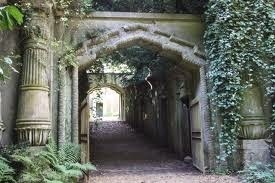
Highgate Cemetery is another of those places that have been on my bucket list for years. I’ve always wanted to visit, but somehow never had the luxury of time in order to add it to past itineraries. So, after Kenwood House in the morning, Victoria and I headed over to Highgate via the bus. The bus itself was another thing I’d never done before – whilst navigating my way across London and England via the tube and railway seems easy peasey, the bus system mystified me before Victoria took me in hand and explained all the vagaries of the process. I admit I’m still a bit puzzled, as often during the coming weeks Victoriawould say that the approaching bus wasn’t the one we were waiting for, but let’s get on anyways. Huh? Why are we getting on a bus that isn’t ours? It doesn’t matter, she’d say, climbing aboard. I, of course, followed. Blindly and like a trusting sheep. Granted, we always reached our destination, but I still don’t have the whole bus thing down in my head, so I doubt I’ll be using it again if I’m in London without Victoria (quelle horror!).
The weather was glorious – warm and mild, with bouts of watery sunshine. And I was still wearing my fur lined boots. That morning, Victoria had found me sitting on the side of my bed, applying cushioned bandages to my feet.
“What are you doing?” she’d asked.
“Covering my blisters. Then I’m going to put on socks and then my boots.”
“Not those fur lined boots again!”
“Have to. They’re the only shoes I’ve got with me that don’t cause me to scream in pain with every step.”
“Do you really need all those band aids?” I raised my as yet unbandaged foot so that she could get a better look. “Holy Crow! I had no idea your feet were that bad!”
“Thus the fur-lined boots. And the fact that I’ve got no shame in wearing them in the middle of a balmy English summer. We have so much to do, none of which I want to miss out on, so band-aids it is. As Wellington said, `A man’s gotta do what a man’s gotta do.’”
“He did not. Wellingtondid not say that.”
“You don’t think so?” I said, ripping open another plaster. “I’ll bet he did. Many times. Think about it.”
“Okay, he might have said something along those lines, but who really said it?”
“John Wayne. And maybe Winston Churchill.”
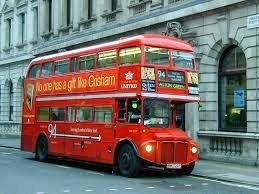
So now here we were, on the bus traveling from Kenwood House in Hampstead towards Highgate Cemetery. As we rode, I thought about what Victoriahad said at Kenwood – that I always expect there to be people at these sites who are dressed in period costume. Sometimes, no kidding, I do find myself a tad disappointed in the reality of a place. I do expect period people to be present. Georgiana should be strolling the grounds at Chatsworth, complete with straw bonnet and a saucy tilt to her chin. Brummell should be sauntering up St. James’s Street with a walking stick in hand and clever insults at the ready. A carriage or two, along with a fresh pile of horse manure, would not go amiss. It would add to the period ambiance. As would a regiment of foot practicing squares in Hyde Park. Or milkmaids standing round Green Park with their cows nearby. I want to eat ices at Gunter’s and present my card at Apsley House, preferably to FitzRoy Somerset himself. I’d like to be able to visit Almack’s in order to see, first hand, just how lousy the refreshments were. I want to look up in the sky and witness balloon ascents. And go to the Exeter Change. I want a waterman to row me across the Thames to Vauxhall Gardens. If I met Caro Lamb and Princess Lieven, would they be as awful as I imagine they were? Would the original Earl Grey tea really taste like the 21st Century blend? How long would I last without Bacardi rum? Did Queen Victoria really bray like a donkey when she laughed? Was Prince Leopold really drop dead gorgeous at the time of his wedding to Princess Charlotte?
“Our stop is next,” Victoriasaid, bringing me out of my reverie. We were almost at Highgate Cemetery– I’d finally be able to strike it off my bucket list. And it would most certainly not disappoint as the place would be filled with period people. Granted, they'd be dead and buried and not on view as they strolled the paths, but technically they'd still be there.
Highgate Cemetery Coming Soon!
Published on January 01, 2015 23:00
December 31, 2014
THE PASSING OF THE 8TH DUKE OF WELLINGTON

THE TELEGRAPH
THE GUARDIAN
THE DAILY MAIL
BBC NEWS
________________________________________________________________________________
Published on December 31, 2014 16:02
Kristine Hughes's Blog
- Kristine Hughes's profile
- 6 followers
Kristine Hughes isn't a Goodreads Author
(yet),
but they
do have a blog,
so here are some recent posts imported from
their feed.





